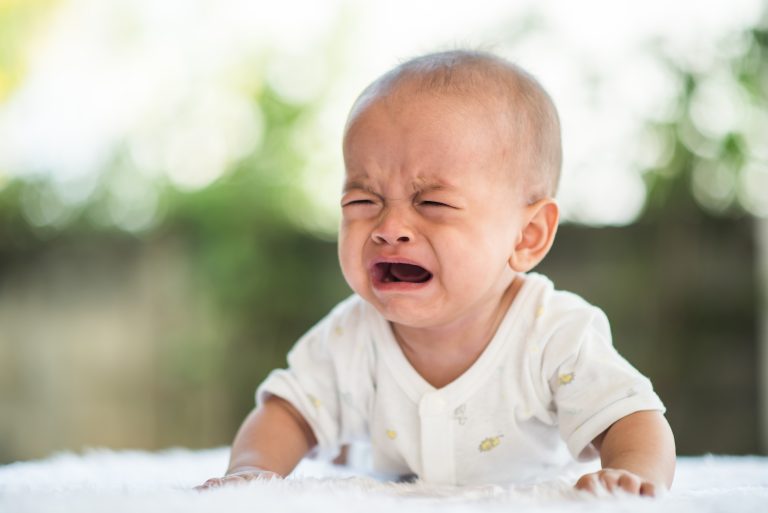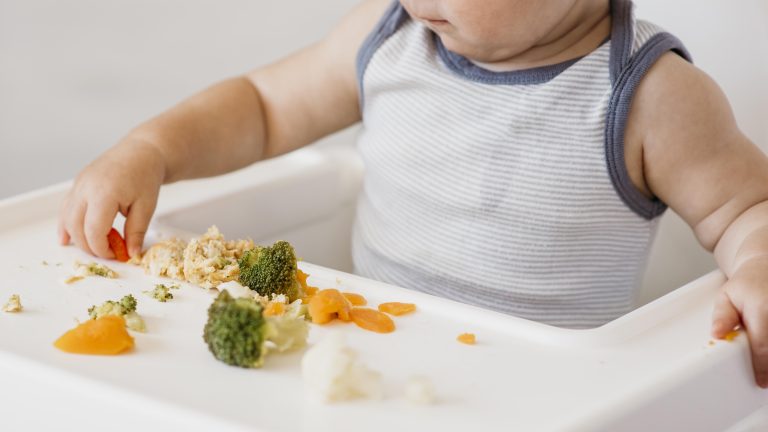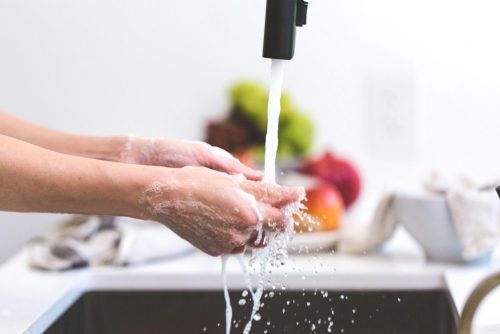Stomach Flu in Children and What to Do

Gastroenteritis (Stomach Flu) refers to a gut (intestine) infection where there is diarrhoea (frequent passage of loose or watery stools). The infection is frequently accompanied by vomiting, which typically lasts 6 to 24 hours. Diarrhoea usually lasts 2–4 days. Occasionally, it may go on for 10–14 days. This article answers some common questions that you may have about your child’s vomiting or diarrhoea.
What Causes Your Child’s Vomiting and Diarrhoea? Are They a Serious Problem?
Many types of illnesses and medicines can cause your child’s vomiting or diarrhoea. Most often, vomiting and diarrhoea are caused by a germ called a virus. Vomiting and diarrhoea are the body’s way of getting rid of an infection or telling us that something is wrong. Infection by a virus is usually mild and does not last longer than 1 week. Your child should get better if he or she gets lots of rest, liquids, and good food. But in certain cases, your child’s illness may get serious. That can happen because vomiting and diarrhoea take water and salt away from your child’s body. If your child does not replace water and salt by drinking the right liquids, he or she can become dry. This is called dehydration and can be very serious if your child is a baby or is very young.
Do Medicines Help?
Using medicines to stop vomiting or diarrhoea may harm your child. Do not give your child medicines that
- You can buy them off the shelf in a drugstore (for example, Gravol, Imodium, and Kaopectate).
- Were ordered or prescribed for another person.
- Were ordered for an illness your child had before.
Your child does not need antibiotics for most illnesses that cause vomiting and diarrhoea. (Antibiotics are medicines that fight some infections.) Antibiotics do not cure viruses.
When Should Your Child See a Doctor?
Your child should see a doctor if he or she has any of the warning signs of serious vomiting or diarrhoea. The warning signs can be different for each child. Watch your child closely. Pay attention to things that you think are different about your child’s behaviour.
See a doctor if your child has ANY of the WARNING SIGNS on this list:
- Not willing to drink
- No tears when crying
- Vomiting often for more than 4 to 6 hours
- Sunken eyes
- More than 6 large, watery diarrhoeas in 1 day
- Stomach pain that is severe and does not stop
- Less than 5 wet diapers in 1 day
- Fast breathing
- Dry skin, mouth, and tongue
- Very sleepy or very fussy
- Cool or grayish skin
- Severe head or neck pain
- Green vomitus
- Blood in the vomit or diarrhoea
- Bringing the knees up to the stomach and crying
- Fever over 39°c, or 102.2°f, for longer than 12 hours
- Sunken fontanelle (the soft spot on your child’s head if he or she is less than 18 months old)

What Should You Do to Care for Your Child?
When your child is experiencing vomiting or diarrhoea, providing the right care is crucial for their recovery. Use oral rehydration therapy to manage and rehydrate them. Additionally, offering healthy foods can help support their healing process.
Rehydration
Give your child a special liquid called an oral electrolyte solution to prevent serious dehydration. Dehydration happens when your child’s body loses water and too many salts. For the first 6 hours, make sure your child gets at least the right amount for his or her age.
What Is an Oral Electrolyte Solution?
An oral electrolyte solution is a liquid that has exactly the right amount of water, sugar, and salt. You can buy this solution in most drugstores in different forms:
- Drinks, such as Pedialyte, Repalyte or Hydralyte
- A powder that you must mix with water, such as Oral Rehydration Salts
Warning: You must mix the powder exactly as the instructions on the package say. This means you must use measuring spoons and measuring cups to measure the powder and the liquid. Not following these instructions may harm your child.
How Much to Feed Your Child?
- For a child less than 6 months old: Give 60 to 90 mL (12 to 18 teaspoons) every hour.
- For a child 6 months to 2 years old: Provide 90 to 125 mL (18 to 25 teaspoons) every hour.
- For a child 2 years or older: Offer 125 to 250 mL (4 to 8 ounces) every hour.
If you are breastfeeding, continue to do so, but offer shorter, more frequent feedings. Breast milk remains the best liquid for your child. If your child is vomiting, use a teaspoon or syringe to give 5 mL (1 teaspoon) of liquid every 1 to 5 minutes. Avoid large drinks, as they may worsen vomiting. As your child begins to feel better, offer larger amounts less frequently but ensure they continue to get enough liquid. After 24 hours, give the oral electrolyte solution only after each episode of watery diarrhoea. Avoid sugary liquids like apple juice, Kool-Aid, and soft drinks, as they can worsen diarrhoea.
Tip: Start with small sips of the oral electrolyte solution to help your child adjust to the taste, which may be new to them.
Provide Healthy Foods to Aid in Recovery
Feeding your child healthy foods, milk, or formula will help fight your child’s infection. It will also help heal his or her stomach and intestines and prevent loss of weight. If your child is vomiting, temporarily stop giving solid foods for 6 to 12 hours, but continue breastfeeding, as it is the best nutrition for them. If your child has diarrhoea, do not withhold food. Instead, offer small amounts of preferred foods every 3 to 4 hours. Starchy foods like bread, cereals, pasta, and rice, as well as fresh fruits and vegetables, are ideal. Avoid introducing new foods or those high in sugar and fat.
Here is a list of the good foods that you should feed your child. Do not feed your child foods that are on the list of bad foods.
Do Feed Your Child
- Breast milk, regular milk with no water added, or formula
- Starchy foods, such as rice, potatoes, noodles, toast, and crackers
- Cereals, such as rice or wheat cereal, and oatmeal
- Proteins like boiled or baked meat, fish, and chicken, and soya and eggs
- Vegetables without added butter
- Fruits not packed in syrup
- Soup
Do Not Feed Your Child
- Grape juice, apple juice, orange juice, soft drinks, or ginger ale
- Ice cream or sherbet
- Sweetened cereals
- Fatty foods such as French fries, hamburgers, and butter
- Spicy foods
Help Lower the Chances of Your Child Getting Sick
- Wash your hands after touching raw meat, chicken, or fish.
- Keep meats that are not being eaten or cooked in the refrigerator.
- Do not feed your child meats that are not cooked enough, particularly chicken and hamburgers.
- Throw away eggs with cracked shells. Do not feed your child raw eggs.
- Use different cutting boards for raw meats and other foods.
Do not let your child get dehydrated. Keep a supply of a special liquid called oral electrolyte solution in your home. Drinking this liquid helps to put salt and water back into your child’s body when he or she has vomiting or diarrhoea.
Prevent Your Child’s Illness from Spreading

- Keep your child at home until the vomiting and diarrhoea stop.
- Ask all who enter your home to wash their hands after changing diapers or using the toilet, after your child vomits, and before preparing or eating food.
- Do not let anyone share eating utensils, such as forks, knives, spoons, and chopsticks, or toothbrushes or drinking cups. If your child puts toys in the mouth, do not let him or her share toys.
Protect Your Child’s Bottom
- Change your child’s diapers frequently.
- Clean your child’s bottom with soap and water. Rinse thoroughly and gently pat dry or allow it to air dry. Avoid using baby wipes.
- Apply a protective cream to your child’s bottom to help prevent skin irritation caused by diarrhoea.
Conclusion
Gastroenteritis, or stomach flu, can be a challenging experience for children and their families. By being well-informed and prepared, you can help your child recover fast. SBCC Baby and Child Clinic is also here to help families through such difficult situations by providing professional care. Parental vigilance, timely attention, and well-suited support are essential to a child’s rapid recovery and uninterrupted childhood joy.









